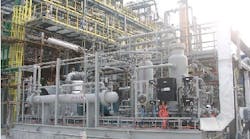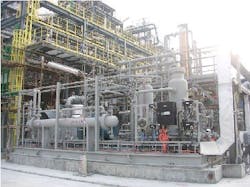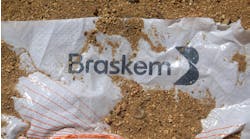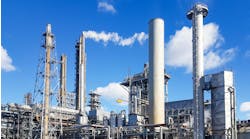Exact figures may be hard to come by, given the complexity of the chemical industry, but separation processes have been estimated as accounting for somewhere between 40% and 70% of its capital and operating costs. Add in petroleum refining and you have an industrial sector that requires 45% of its annual energy consumption simply to separate products from its main process streams. Not surprisingly, therefore, energy-intensive separation processes like distillation are facing increasing competition from a variety of alternative technologies.
When the Chemical Industry Vision2020 Technology Partnership was set up in 1996 (see CP, October 2005, p. 16), one of its aims was to establish a series of “roadmaps” that might guide the development of new processes and unit operations. When its “separations roadmap” was published in 2000, the technologies deserving priority for more concerted development efforts had been winnowed to six — adsorption, crystallization, distillation, extraction, membranes and separative reactors. The thinking was that, although some technologies have been around a lot longer than others, no separation process has really reached full maturity — at least in the sense that no further improvements are possible.
Membrane moves
Times change, however, and much more effort — both academically and industrially — now appears to be going into developing robust and reliable alternatives to energy-thirsty thermal separation processes like distillation. Government, too, has added its backing for developing innovative separation technologies, even those of a high-risk nature. Charles Russomanno of the Office of Energy Efficiency and Renewable Energy at the U.S. Department of Energy (DOE), Washington, D.C., who fields applications for project funding under the Small Business Innovation Research Program, says that membrane technology, in particular, offers a viable alternative to conventional energy-intensive separations.
“Successful membrane applications today,” he reports, “include producing oxygen-enriched air for combustion, recovering and recycling hot wastewater, VOC [volatile organic compound] recovery, and hydrogen purification.” Combined with conventional techniques like distillation, membranes can help to deliver improved product purity at lower cost, says Russomanno. There are obstacles in the way, though. “Technical barriers include fouling, instability, low flux, low separation factors and poor durability,” he says. The DOE is looking for projects that will lead to new generations of organic, inorganic and ceramic membranes that will demonstrate greater thermal and chemical stability, better reliability, improved resistance to fouling and corrosion, and higher selectivity.
It might seem a tall order but a great deal of work has already been done, and a great deal more is in progress, as William Koros of the school of chemical and biomolecular engineering at the Georgia Institute of Technology, Atlanta, Ga., explains. “The realization that membranes require treatment as a cross-disciplinary specialty area,” he says, “has enabled movement of the technology from the lab into commercial reality. It’s critical to maintain this perspective to position membranes so they can economically handle more-aggressive feed streams.”
As he points out, the first large-scale commercially viable application of membrane technologies was the reverse osmosis (RO) purification of salt water. However, optimization of the membrane materials and structures for this application took place over 20 years, and only fairly recently has RO started taking over from thermal desalination plants. So, will it take as long for non-aqueous RO separations to find a niche? Koros thinks not: “There is no need to wait for the ‘ultimate’ membrane to be perfected before we can begin benefiting from the savings associated with membrane separations.” He says that reconfiguring existing thermal processes to produce vapor feeds to membrane units — based on existing gas-separation units — for targeted fractionations of valuable components could be an attractive evolutionary strategy.
Potentially, he says, membranes have all the characteristics of a “disruptive technology,” one that could bring about huge reductions in energy intensity in large-scale separations. “But they are not ready yet for aggressive hydrocarbon feeds,” a situation his own research work is set on remedying. “The key to the success of polymeric membranes,” he explains, “is that basically they’re so inexpensive. But they’re not very robust. We’re focusing on a type of bridge technology, hybrid materials with inorganics dispersed within a polymer. So you end up with some of the economics of polymerics and some of the strengths of inorganics.”
Hybrid hopes
Current hybrids on the market typically include around 10% to 15% of inorganics — usually ceramic type materials — interspersed within the polymer structure. “But if you could move that ratio the other way, then that’s where the revolution would happen. Even if the cost was, say, 10 times that of a polymer membrane, with the extraordinary performance offered by inorganics then it, too, would become a disruptive technology — it changes everything,” says Koros.
His group is looking at zeolites or carbon as the inorganic component of hybrids. Carbon holds out more promise, as these membranes are easier to manufacture on a large scale. Basically, they can be made by pyrolyzing an asymmetric polymer membrane so that the thin (0.1-0.2 μm) surface layer stays in place while the body of the asymmetric structure is effectively transformed into a molecular sieve.
“You get extraordinary diffusion coefficients, much higher than with zeolites, so these carbons have the potential to be much more productive on an equivalent thickness basis,” he says.
Blue Membrane (BlueM), Wiesbaden, Germany, specializes in carbon/ceramic membranes and membrane reactors. CEO Sohéil Asgari says that both are resistant to harsh conditions such as temperatures up to 800ºC and the full range of pH from 1 to 14. The BlueM membranes are available as inorganic carbon/ceramic, composites or mixed matrix membranes with inorganic and organic textures. The company supplies membranes tailored to suit the particular project.Compared to conventional polymeric membranes, he says the carbon/ceramic or composites can be tailored in selectivity and permeability for gas and liquid separation. They can also be produced in different configurations, such as “spacerless” honeycomb modules with cross-flow or linear-flow geometries. Tubular carbon[/ceramic elements have been developed for a wide range of applications, such as recovering high-value pharmaceutical precipitates, or for pre- and post-treatment stages with other separation technologies like RO, ion exchange or adsorption.
The carbon[/ceramic membranes are compatible with aggressive fluids like liquid sulfur and ammonia, can handle the recovery of catalysts in peroxide production, and offer the chemical inertness and temperature resistance the food industry demands to ensure sanitary operations.
Hybrid membranes could be said to be at the cutting edge of developments, but work is very much in progress on further developing conventional polymeric-based membranes. For instance, Membrane Technology and Research, Menlo Park, Calif., which since 1996 has offered VaporSep systems for recovery of propylene from petrochemical waste gases (Figure 1), recently introduced a new membrane for achieving high recovery of purified hydrogen. The first two commercial installations are expected to start up this year.
Figure 1. This polymeric-based-membrane unit at the SECCO petrochemical complex in Shanghai, China, recovers 1.5 tons/hr of 95%-pure propylene from vent streams.
Another company now beginning to see the fruits of earlier development is Membrane Extraction Technology (MET), London, U.K., a spin-off from the chemical engineering department of London’s Imperial College. MET has worked closely with the Grace Davison division of W.R. Grace, Columbia, Md., since 1999 and is the exclusive European supplier and application-developer for the fine chemicals and pharmaceuticals markets of that company’s Starmem range of nanofiltration membranes. Resistant to aromatic and aliphatic hydrocarbons, alcohols, ketones and esters, these membranes have had considerable success in organic solvent nanofiltration, including the recovery and reuse of phase-transfer catalysts, organometallic catalysts and chiral hydrogenation catalysts.
Starmem membranes also have been successfully used to swap solutes dissolved in high-boiling-point solvents to ones with a lower boiling point. MET’s business development manager Lina Christopolou gives the example of the phase-transfer catalyst tetraoctyl-ammonium bromide being swapped from 100% toluene solvent to 99.7% methanol, with less than 1% loss of catalyst. She says the benefits of this type of solvent swapping include its efficiency — producing less than one-third of the waste generated by distillation, its suitability for thermally sensitive materials, and insensitivity to azeotrope formation, for which it is “an excellent alternative to distillation.”
Pervaporation progress
One area where distillation has always had distinct drawbacks is in the handling of azeotropic mixtures. It is perhaps here that membrane technology — in the form of pervaporation — shows the most promise. As the name implies, pervaporation combines permeation and evaporation. Components of a liquid mixture are brought into contact with one side of a permeable nonporous membrane while a vacuum or gas purge is applied to the other side. The components have different affinities for the membrane and pass through it at different rates. The composition of the vapor produced on the other side of the membrane can differ dramatically from that evolved during a conventional distillation process.
According to Frank Seibert, technical manager of the separations research program at the University of Texas at Austin and director of the Separations Division of the American Institute of Chemical Engineers, “[Pervaporation] took off in Europe 10 to 15 years ago, when energy prices were high. Economically it was viable there, but not really in the U.S. when energy prices were a lot lower than they are now. But perhaps now it may start looking more attractive.”
Those early applications were mainly for the removal of water from organic solvents; the U.S. Environmental Protection Agency’s National Risk Management Research Laboratory at Cincinnati, Ohio, is now focusing part of its membrane development efforts in that area. Primary investigator Leland Vane reports the project aims to fabricate novel polymer/ceramic mixed membranes for the dehydration of alcohol, particularly isopropyl alcohol, which is used in many industries as a solvent and cleaning agent. One of the early goals is to develop a Pervaporation, Performance, Prediction Software and Database program to give potential users a means of assessing applications of pervaporation through computer modeling and simulation.
In the commercial world meanwhile, Sulzer Chemtech, Pasadena, Texas, continues to evolve its range of Pervap composite polymer membranes. These use an active PVA separating layer that preferentially permeates water. The crosslinking of this layer determines the way the membrane behaves in terms of permeate flux, selectivity and chemical resistance. Less-crosslinked membranes are now being used to separate methanol from other organics.
Real attractions
Just as membrane technologies are clearly gaining ground in sectors that were previously unaware of their potential, so too are other separation technologies such as simulated moving bed (SMB) chromatography. First developed in the 1960s for purification processes in the sugar industry and later taken up by refiners in the form of UOP’s Sorbex process for the purification of xylene isomers, SMB chromatography is now showing great promise in the pharmaceuticals and bioprocessing sectors, as reported in CP, September 2005, p. 38.
For instance, Ampac (formerly Aerojet) Fine Chemicals in Rancho Cordova, Calif., runs production-scale SMB units for a number of major pharmaceuticals producers, notes Olivier Dapremont, its director for chromatographic separations and co-author of the article. “We have a process here that we have been running for five years on the same separation,” he says, “with only the occasional break for maintenance or between production campaigns. It’s a very stable operation and is one of the reasons why the technology is starting to take off now.”
However, despite this growing interest in SMB, relatively few companies as yet offer the technology, whether on a custom-processing basis as at Ampac or for purchase. Dapremont acknowledges that this lack of choice could be a limiting factor. “If you want to use, say, crystallization for your separations, there may be a hundred or more companies out there to choose from — giving you much more flexibility and so perhaps less inclination to try SMB,” he observes. “But it’s the same with any new technology. You need to have a certain critical mass [of users] to keep the interest going.”
That’s not really a problem with long-established separation techniques like liquid/liquid extraction, but even here there are developments that are very much leading edge. One is the use of low-frequency high-intensity sound energy to improve mixing. Developer Resodyn of Butte, Mont., offers two variants of mixer technology: the ResonantAcoustics and the ResonantSonics (which operates in the audible spectrum), both of which are said to dramatically improve gas/liquid and liquid/liquid mixing over conventional agitator-driven techniques. Available as standalone RAM80 Resonant/Acoustic mixer units, they also are being developed as part of bioreactor units.
Despite distillation’s predominant position, it’s clear that choices in separations technology are in flux.



